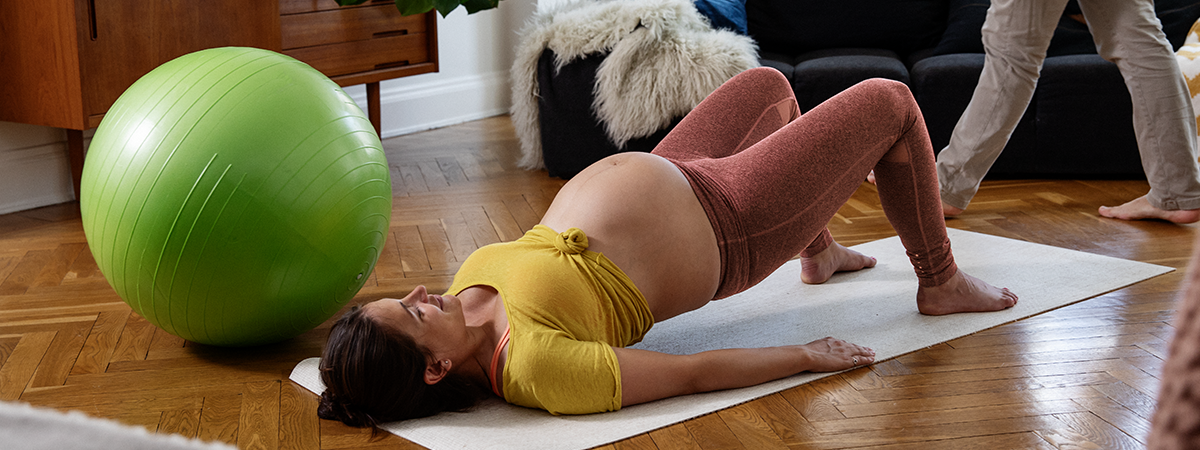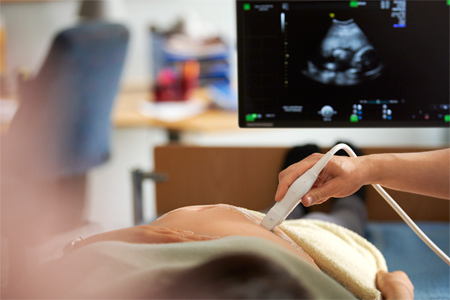Exercise during pregnancy

You’ve surely heard it before – exercise is good for us. It strengthens the immune system and improves energy, sleep, mental health and more. But during pregnancy, there are actually even more reasons why it’s smart to get moving. We’ll go through them here – along with how to approach exercise each trimester.
Even if you’ve never exercised before, you’ve got a great reason to start when you’re pregnant. Beyond the fact that it strengthens your body both physically and mentally, it also reduces your risk of the various ailments that can happen during pregnancy, like nausea, back and pelvic pain, constipation, varicose veins and gestational diabetes – plus, it’s a great way to help your body recover after childbirth. Already having some degree of basic strength and conditioning in place is important for your body’s recovery. Muscle mass is lost quickly, but it takes a long time to build up, so focus on maintaining what you’ve got to the best of your ability.
What is the best kind of exercise to do while pregnant?
In general, the best exercise is the one that you actually do and that feels good! Through your first trimester, you can keep on doing what you’re doing when it comes to most sports and physical activities. The changes to your body will be gradual and our unique bodies all have a different baseline – so things won’t be that different due to pregnancy yet. And of course, your personal preferences won’t change just because you’re pregnant. So focus on what gives you energy and what you think is fun. Some people like taking walks, others like going to the gym, some people enjoy running or going to yoga.
Aim for 150 minutes/week, or about 20 minutes/day, of exercise that increases your heart rate. Try for short, frequent bursts rather than lengthy but rare workouts – this isn’t just about getting your heart rate up, but also avoiding sitting still too much in daily life. Getting up to stretch your legs and generally aiming to move often is a good idea – especially if your job is fairly sedentary. It’s also smart to incorporate some kind of strength training involving the major muscle groups (i.e., your back, butt and thighs) at least twice per week. If you’re looking for tips on exercises you can do at home while pregnant, we’ve got a handful of ideas further down in this article. And if your pregnancy has involved complications (see below), you should always talk to your doctor/midwife, or consult a physiotherapist who is knowledgeable about pregnancy, about how you should approach exercise.
Can you do ab exercises during pregnancy?
Maybe you’ve heard that pregnancy causes some of the abdominal muscles to separate after a while, and it is indeed reasonable to ask how to do core exercises while pregnant. In your first trimester, you can usually do planks and sit-ups if you want to, but after your abdominal muscles have separated (usually around week 20 for first-time pregnancies; earlier if you’ve had a baby before), you will probably need to find other abdominal exercises to avoid putting too much pressure on your back. At that point it’s best to focus more on the primary function of your back and abdominal muscles: holding your body steady as your arms and legs move. You can train these muscles with arm exercises using resistance bands or dumbbells while holding your back and belly still.
Strength training while pregnant
Strength training is often fine when you’re pregnant – but strength is relative, so it depends a bit on your baseline. Because your body contains more of the hormone relaxin during pregnancy, you’ll also have to get used to the fact that your joints will be slightly more elastic; avoid drawing comparisons to what you could handle before. Skip anything that doesn’t feel good and modify by doing fewer reps with lower weights. Long levers, for example with deadlifts, might not feel very good when you’re pregnant – especially not after abdominal separation, so skip those exercises. Your body will often respond to your workout already the next day, so pay attention and listen carefully to its signals. The usual exercise-related soreness will fade after a few days; pain from doing something wrong or training too hard won’t pass as quickly. From week 16 of your pregnancy, do strength training exercises while seated, standing, or on your side to avoid supine hypotensive syndrome, which can cause dizziness and nausea.
How do I approach exercise during each trimester?
Pregnancy is long and your body undergoes a huge transformation on the road to childbirth. So you will have to modify your workout for each trimester. It’s also important to be sensitive to the fact that we’re all different – so figure out what feels good for you.
Exercise during the first trimester
Exercising early in pregnancy isn’t usually a problem, because your belly hasn’t gotten big enough to be in the way, nor is it putting much extra weight on your joints and ligaments. Choose your exercise based on what feels okay for your body and what you can handle, of course. Nausea and fatigue are also quite common during the first trimester, and the thought of starting to exercise might feel overly ambitious. It may help boost your motivation to know that physical activity actually helps alleviate worries and troublesome symptoms during pregnancy. During your first trimester, you can start building strength around your back and belly, because a heavy belly puts a lot of strain on your back, and no matter what your body looks like, your belly is going to get bigger as time goes on.
Exercise during the second trimester
The second trimester often brings more energy and you might feel like you can do more in the evenings again. So it may be a good idea to find a pregnancy workout, like water aerobics, yoga, or a group class that doesn’t involve jumping or bouncing. Walking or cycling are great options. Gym workouts are usually still okay too, because it’s easy to modify them with weights you can manage and exercises that don’t put too much strain on your body.
There are also activities that are no longer great options at this point, like football or other team sports, martial arts, or other activities with a lot of speed, a risk of falling, or any hits to the belly. The growing size of your tummy also affects the load on your body and once your abdominal muscles have separated, it will impact what kind of stomach exercises you can do. It’s smart to keep doing exercises that strengthen your back and belly, but you probably have to modify them at this point. To avoid getting dizzy or nauseous, skip back exercises that are done lying down. For a lot of people at this point, running or carrying and lifting heavy weights will no longer feel good. If it’s no longer comfortable, for example if exercise causes urine leaks or knee or back pain, then it’s time to modify how you exercise. You can always ask a physiotherapist or personal trainer if you are uncertain.
If you’re having pregnancy-related pelvic pain that worsens with too much activity, then do arm exercises, or do exercises on all fours. Aim for mellow exercises that still strengthen the back and belly, but that don’t strain the pelvis the way walking does, for example. Now in the second trimester, it’s also a good idea to start doing your Kegels and finding the muscles of your pelvic floor.
Exercise during the third trimester
The third trimester presents some challenges related to stamina, more weight and shortness of breath. It might be time to start cultivating your introvert side and focusing on some lower key exercise. But you should also continue with conditioning and strength training at a pace that your body can manage. Breathing and relaxation are great things to practice in your third trimester; this will help you relax tense muscles in your shoulders and back. Breathing exercises are also a good way to prepare for childbirth, because controlled breathing, with a long exhale, is actually calming and soothes pain. You can practice this a few different ways: by counting 3-second inhales and 6-second exhales, or box breathing with 4-4-4-4: inhale for 4 seconds, hold for 4 seconds, exhale for 4 seconds, and hold for 4 seconds.
Because your belly is so big and putting heavy pressure on the pelvis now, do continue with your pelvic floor exercises to prevent urinary incontinence. It’s best to do these exercises on your side, back, or all fours.
Are there any exercises you should avoid during pregnancy?
Like we said before, from the middle of pregnancy, it’s best to avoid exercises or sports that could involve falling or any hits to the stomach. The bigger your belly gets, the bigger the load on your body becomes – especially on your pelvis – so think about being gentle on your body and reducing jumps and bumps in exercises where your feet are off the ground. Not jumping on a trampoline while pregnant (or after) is a good way to be kind to your pelvis.
Exercise might be discouraged with certain conditions, such as anaemia (deficiency in red blood cells), persistent bleeding, cervical weakness, twins, triplets or multiples, preeclampsia or high blood pressure during pregnancy. Pelvic pain may also make you uncertain about whether it’s a good idea to exercise. Pelvic pain often gets worse the more you move, and can be more severe at night and feel better in the morning. The challenge is to find a form of exercise that doesn’t cause more pain. Your baseline is especially important in that case, as well as the amount of resistance. It’s important that you don’t completely lose strength in your muscles, both now so that you can carry your pregnant body, and later, to make recovery easier after delivery.
Tips for a great workout while pregnant
Like we said, the best thing you can do is to try to get plenty of movement every day, combined with workouts that get your pulse up. Complement that with a few pregnancy exercises to build strength, for example:
- Work out your belly and back with arm exercises. Stand stably, draw your pelvis slightly underneath you to lift your belly, then do various dumbbell exercises or resistance band exercises – like rowing, biceps and triceps.
- You can also try standing in a walking position, with one foot in front of the other, when doing your arm exercises. Here too, the goal is to hold your body still while your arms work.
- Exercise on all fours, for example by arching and rounding your spine, lifting your belly, and holding for 10 seconds.
- Stand on a balance board to strengthen the muscles in and around your back and belly.
Please note that all information above is based on Swedish recommendations.

